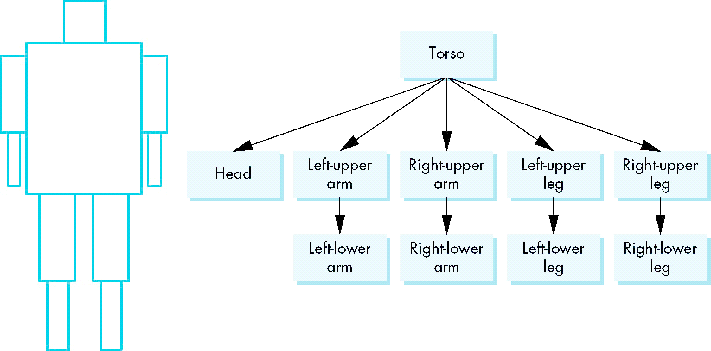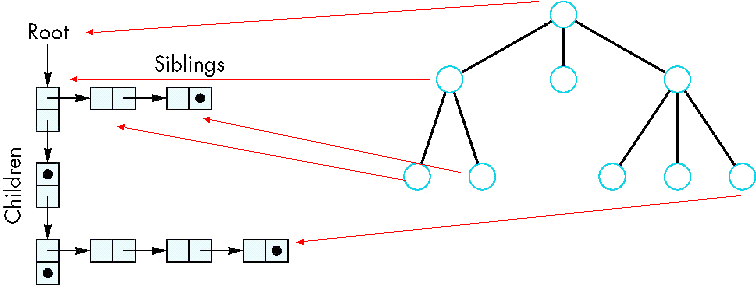CHAPTER 10 - Implementation 2
- Build a tree-structured model of a humanoid figure
- Examine various traversal strategies
- Build a generalized tree-model structure that is independent of the particular model
Humanoid Figure

Building the Model
- Can build a simple implementation using quadrics: ellipsoids and cylinders
- Access parts through functions
- torso()
- left_upper_arm()
- Matrices describe position of node with respect
to its parent
- Mlla positions left lower leg with respect to left upper arm
Tree with Matrices

Display and Traversal
- The position of the figure is determined by 11 joint angles (two for the head and one for each other part)
- Display of the tree requires a graph traversal
- Visit each node once
- Display function at each node that describes the part associated with the node, applying the correct transformation matrix for position and orientation
Transformation Matrices
- There are 10 relevant matrices
- M positions and orients entire figure through the torso which is the root node
- Mh positions head with respect to torso
- Mlua, Mrua, Mlul, Mrul position arms and legs with respect to torso
- Mlla, Mrla, Mlll, Mrll position lower parts of limbs with respect to corresponding upper limbs
Stack-based Traversal
- Set model-view matrix to M and draw torso
- Set model-view matrix to MMh and draw head
- For left-upper arm need MMlua and so on
- Rather than recomputing MMlua from scratch or using an inverse matrix, we can use the matrix stack to store M and other matrices as we traverse the tree
Traversal Code


Analysis
- The code describes a particular tree and a
particular traversal strategy
- Can we develop a more general approach?
- Note that the sample code does not include
state changes, such as changes to colors
- May also want to use glPushAttrib and glPopAttrib to protect against unexpected state changes affecting later parts of the code
General Tree Data Structure
- Need a data structure to represent tree and an algorithm to traverse the tree
- We will use a left-child right sibling
structure
- Uses linked lists
- Each node in data structure is two pointers
- Left: next node
- Right: linked list of children
Left-Child Right-Sibling Tree
Tree node Structure
- At each node we need to store
- Pointer to sibling
- Pointer to child
- Pointer to a function that draws the object represented by the node
- Homogeneous coordinate matrix to multiply
on the right of the current model-view matrix
- Represents changes going from parent to node
- In OpenGL this matrix is a 1D array storing matrix by columns
C Definition of treenode
typedef struct treenode {Glfloat m[16];
void (*f)();
struct treenode *sibling;
struct treenode *child; } treenode;
Defining the torso node
treenode torso_node, head_node, lua_node, … ;
/* use OpenGL functions to form matrix */
glLoadIdentity();
glRotatef(theta[0], 0.0, 1.0, 0.0);
/* move model-view matrix to m */
glGetFloatv(GL_MODELVIEW_MATRIX, torso_node.m)
torso_node.f = torso; /* torso() draws torso */
Torso_node.sibling = NULL;
Torso_node.child = &head_node;
Notes
- The position of figure is determined by 11 joint angles stored in theta[11]
- Animate by changing the angles and redisplaying
- We form the required matrices using glRotate
and glTranslate
- More efficient than software
- Because the matrix is formed in model-view matrix, we may want to first push original model-view matrix on matrix stack
Preorder Traversal
void traverse(treenode *root) {
if(root == NULL) return;
glPushMatrix();
glMultMatrix(root->m);
root->f();
if(root->child != NULL) traverse(root->child);
glPopMatrix();
if(root->sibling != NULL) traverse(root->sibling);
Notes
- We must save modelview matrix before
multiplying it by node matrix
- Updated matrix applies to children of node but not to siblings which contain their own matrices
- The traversal program applies to any left-child
right-sibling tree
- The particular tree is encoded in the definition of the individual nodes
- The order of traversal matters because of possible state changes in the functions
Dynamic Trees
- If we use pointers, the structure can be dynamic
- typedef treenode *tree_ptr; tree_ptr torso_ptr; torso_ptr = malloc(sizeof(treenode));
- Definition of nodes and traversal are essentially the same as before but we can add and delete nodes during execution


